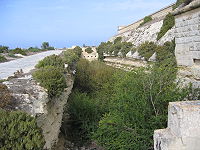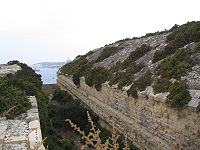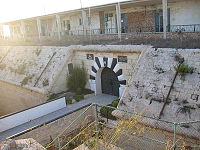
Polygonal fort
Encyclopedia
A polygonal fort is a fortification
in the style that evolved around the middle of the nineteenth century, in response to the development of powerful explosive shells
.
The complex and sophisticated designs of star fort
s that preceded them were highly effective against cannon assault, but proved much less effective against the more accurate fire of rifled guns and the destructive power of explosive shells. The polygonal style of fortification is also described as a "flankless fort". Many were built during the government of Lord Palmerston, and so they are also often referred to as Palmerston forts. Their low profile makes them easy to overlook.
In response to the vulnerabilities of star forts, military engineers evolved a much simpler but more robust style of fortification.
 The ditch became deep and vertical sided, cut directly into the native rock. It was laid out as a series of straight lines surrounding the fortified area that gives this style of fortification its name.
The ditch became deep and vertical sided, cut directly into the native rock. It was laid out as a series of straight lines surrounding the fortified area that gives this style of fortification its name.
 The ditch was swept by fire from defensive blockhouse
The ditch was swept by fire from defensive blockhouse
s (caponier
s) set in the ditch, and firing positions cut into the outer face of the ditch itself (counterscarp battery).
The profile of the fort becomes very low indeed, surrounded outside the ditch by a gently sloping open area (glacis
), so as to provide no protection for an enemy while the fort itself provides a minimal target for enemy fire, and the narrow ditch a difficult target for plunging
shellfire.
The counterscarp
, (the outside of the ditch) is usually vertical, while the upper edge of the scarp is steeply sloping and often revetted
in stone, to help shed shells into the ditch.
Access to the fort was down a curving ramp cut into the glacis, then through a gatehouse
set deep in the scarp of the ditch, reached by a rolling bridge
that withdrew into the gatehouse.
 The majority of the fort is underground, with deep passages giving access to the counterscarp batteries and the ditches defensive blockhouses (caponniers) from within the fort.
The majority of the fort is underground, with deep passages giving access to the counterscarp batteries and the ditches defensive blockhouses (caponniers) from within the fort.
Magazine
s and machinery halls are deep under the surface, with only the emplacements for the fort's gun
s exposed at the surface.
Perhaps surprisingly the guns were often mounted in open emplacements, known as "en barbette
", simply protected by a parapet
. This was not only to lower the outline of the fortress, but also because guns of this period were rifled muzzle loaders (RML), still using black powder as their propellant
, which generated large amounts of fumes and smoke.
Because of the fast burning propellant, gun barrel
s were short, and accuracy still relatively low. Experience had shown that guns could be put out of action by collapsing their casemates around them by bombardment. The gun in its open emplacement was a much harder target to hit than the massive face of a casemate.
The polygonal forts provided robust and defendable gun platforms. They were built in the context of a larger defensive scheme, as forward batteries
to engage the enemy and prevent them bombarding more vulnerable targets, like city
rail centre
s and dockyards.
Forts of this style were built extensively from the middle of the nineteenth century, but the end of the century saw the development of slower burning propellants
, which allowed longer guns with much better range and accuracy and that produced much less smoke, and this along with the increasing reliability of breech-loading guns, favoured fortifications completely underground except for massive steel cupolas containing the guns.
The increasing range of field artillery
also required corresponding increases in the depth of zone that forts needed to be defend to prevent bombardment of the resources being defended.
Meanwhile the development of machine guns and barbed wire
offered a more flexible and much cheaper means of protecting from infantry
assault
compared to the polygonal fort's ditches and blockhouses.
Many of the polygonal forts continued in service, even through the Second World War
, since they provided convenient strongpoints, and their open emplacements readily accepted anti-aircraft batteries
and quick firing guns
, but the art of fortification had moved on.
Fortification
Fortifications are military constructions and buildings designed for defence in warfare and military bases. Humans have constructed defensive works for many thousands of years, in a variety of increasingly complex designs...
in the style that evolved around the middle of the nineteenth century, in response to the development of powerful explosive shells
Shell (projectile)
A shell is a payload-carrying projectile, which, as opposed to shot, contains an explosive or other filling, though modern usage sometimes includes large solid projectiles properly termed shot . Solid shot may contain a pyrotechnic compound if a tracer or spotting charge is used...
.
The complex and sophisticated designs of star fort
Star fort
A star fort, or trace italienne, is a fortification in the style that evolved during the age of gunpowder, when cannon came to dominate the battlefield, and was first seen in the mid-15th century in Italy....
s that preceded them were highly effective against cannon assault, but proved much less effective against the more accurate fire of rifled guns and the destructive power of explosive shells. The polygonal style of fortification is also described as a "flankless fort". Many were built during the government of Lord Palmerston, and so they are also often referred to as Palmerston forts. Their low profile makes them easy to overlook.
In response to the vulnerabilities of star forts, military engineers evolved a much simpler but more robust style of fortification.


Blockhouse
In military science, a blockhouse is a small, isolated fort in the form of a single building. It serves as a defensive strong point against any enemy that does not possess siege equipment or, in modern times, artillery...
s (caponier
Caponier
A caponier is a type of fortification structure. The word originates from the French word "caponnière" - which strictly means capon-cote i.e. chickenhouse.The fire coming from the feature A caponier is a type of fortification structure. The word originates from the French word "caponnière" -...
s) set in the ditch, and firing positions cut into the outer face of the ditch itself (counterscarp battery).
The profile of the fort becomes very low indeed, surrounded outside the ditch by a gently sloping open area (glacis
Glacis
A glacis in military engineering is an artificial slope of earth used in late European fortresses so constructed as to keep any potential assailant under the fire of the defenders until the last possible moment...
), so as to provide no protection for an enemy while the fort itself provides a minimal target for enemy fire, and the narrow ditch a difficult target for plunging
Plunging fire
Plunging fire is gunfire directed upon an enemy from an elevated position, or gunfire aimed so as to fall on an enemy from above.In naval warfare plunging fire was often used to penetrate an enemy ship's thinner deck armor rather than firing directly at an enemy ship's side...
shellfire.
The counterscarp
Counterscarp
A scarp and a counterscarp are the inner and outer sides of a ditch used in fortifications. In permanent fortifications the scarp and counterscarp may be encased in stone...
, (the outside of the ditch) is usually vertical, while the upper edge of the scarp is steeply sloping and often revetted
Revetment
Revetments, or revêtements , have a variety of meanings in architecture, engineering and art history. In stream restoration, river engineering or coastal management, they are sloping structures placed on banks or cliffs in such a way as to absorb the energy of incoming water...
in stone, to help shed shells into the ditch.
Access to the fort was down a curving ramp cut into the glacis, then through a gatehouse
Gatehouse
A gatehouse, in architectural terminology, is a building enclosing or accompanying a gateway for a castle, manor house, fort, town or similar buildings of importance.-History:...
set deep in the scarp of the ditch, reached by a rolling bridge
Guthrie rolling bridge
A Guthrie rolling bridge was a kind of retractable bridge, an 18th century version of the drawbridge. It was commonly installed as the access across the narrow steep sided ditches characteristic of the polygonal forts of this era....
that withdrew into the gatehouse.

Magazine
Magazine (artillery)
Magazine is the name for an item or place within which ammunition is stored. It is taken from the Arabic word "makahazin" meaning "warehouse".-Ammunition storage areas:...
s and machinery halls are deep under the surface, with only the emplacements for the fort's gun
Gun
A gun is a muzzle or breech-loaded projectile-firing weapon. There are various definitions depending on the nation and branch of service. A "gun" may be distinguished from other firearms in being a crew-served weapon such as a howitzer or mortar, as opposed to a small arm like a rifle or pistol,...
s exposed at the surface.
Perhaps surprisingly the guns were often mounted in open emplacements, known as "en barbette
Barbette
A barbette is a protective circular armour feature around a cannon or heavy artillery gun. The name comes from the French phrase en barbette referring to the practice of firing a field gun over a parapet rather than through an opening . The former gives better angles of fire but less protection...
", simply protected by a parapet
Parapet
A parapet is a wall-like barrier at the edge of a roof, terrace, balcony or other structure. Where extending above a roof, it may simply be the portion of an exterior wall that continues above the line of the roof surface, or may be a continuation of a vertical feature beneath the roof such as a...
. This was not only to lower the outline of the fortress, but also because guns of this period were rifled muzzle loaders (RML), still using black powder as their propellant
Propellant
A propellant is a material that produces pressurized gas that:* can be directed through a nozzle, thereby producing thrust ;...
, which generated large amounts of fumes and smoke.
Because of the fast burning propellant, gun barrel
Gun barrel
A gun barrel is the tube, usually metal, through which a controlled explosion or rapid expansion of gases are released in order to propel a projectile out of the end at a high velocity....
s were short, and accuracy still relatively low. Experience had shown that guns could be put out of action by collapsing their casemates around them by bombardment. The gun in its open emplacement was a much harder target to hit than the massive face of a casemate.
The polygonal forts provided robust and defendable gun platforms. They were built in the context of a larger defensive scheme, as forward batteries
Artillery battery
In military organizations, an artillery battery is a unit of guns, mortars, rockets or missiles so grouped in order to facilitate better battlefield communication and command and control, as well as to provide dispersion for its constituent gunnery crews and their systems...
to engage the enemy and prevent them bombarding more vulnerable targets, like city
City
A city is a relatively large and permanent settlement. Although there is no agreement on how a city is distinguished from a town within general English language meanings, many cities have a particular administrative, legal, or historical status based on local law.For example, in the U.S...
rail centre
Urban rail transit
Urban rail transit is an all-encompassing term for various types of local rail systems providing passenger service within and around urban or suburban areas...
s and dockyards.
Forts of this style were built extensively from the middle of the nineteenth century, but the end of the century saw the development of slower burning propellants
Cordite
Cordite is a family of smokeless propellants developed and produced in the United Kingdom from 1889 to replace gunpowder as a military propellant. Like gunpowder, cordite is classified as a low explosive because of its slow burning rates and consequently low brisance...
, which allowed longer guns with much better range and accuracy and that produced much less smoke, and this along with the increasing reliability of breech-loading guns, favoured fortifications completely underground except for massive steel cupolas containing the guns.
The increasing range of field artillery
Field artillery
Field artillery is a category of mobile artillery used to support armies in the field. These weapons are specialized for mobility, tactical proficiency, long range, short range and extremely long range target engagement....
also required corresponding increases in the depth of zone that forts needed to be defend to prevent bombardment of the resources being defended.
Meanwhile the development of machine guns and barbed wire
Barbed wire
Barbed wire, also known as barb wire , is a type of fencing wire constructed with sharp edges or points arranged at intervals along the strand. It is used to construct inexpensive fences and is used atop walls surrounding secured property...
offered a more flexible and much cheaper means of protecting from infantry
Infantry
Infantrymen are soldiers who are specifically trained for the role of fighting on foot to engage the enemy face to face and have historically borne the brunt of the casualties of combat in wars. As the oldest branch of combat arms, they are the backbone of armies...
assault
Assault
In law, assault is a crime causing a victim to fear violence. The term is often confused with battery, which involves physical contact. The specific meaning of assault varies between countries, but can refer to an act that causes another to apprehend immediate and personal violence, or in the more...
compared to the polygonal fort's ditches and blockhouses.
Many of the polygonal forts continued in service, even through the Second World War
World War II
World War II, or the Second World War , was a global conflict lasting from 1939 to 1945, involving most of the world's nations—including all of the great powers—eventually forming two opposing military alliances: the Allies and the Axis...
, since they provided convenient strongpoints, and their open emplacements readily accepted anti-aircraft batteries
Anti-aircraft warfare
NATO defines air defence as "all measures designed to nullify or reduce the effectiveness of hostile air action." They include ground and air based weapon systems, associated sensor systems, command and control arrangements and passive measures. It may be to protect naval, ground and air forces...
and quick firing guns
Rapid Fire
Rapid Fire is the name of several films:*Rapid Fire , starring Brandon Lee*Rapid Fire Other*Rapid Fire,a song by Judas Priest*Rapid Fire , a fictional character in the G.I. Joe universe...
, but the art of fortification had moved on.

